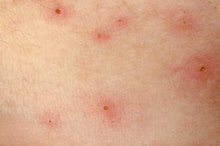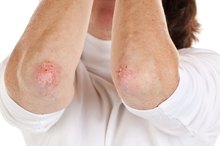What does fact checked mean?
At Healthfully, we strive to deliver objective content that is accurate and up-to-date. Our team periodically reviews articles in order to ensure content quality. The sources cited below consist of evidence from peer-reviewed journals, prominent medical organizations, academic associations, and government data.
The information contained on this site is for informational purposes only, and should not be used as a substitute for the advice of a professional health care provider. Please check with the appropriate physician regarding health questions and concerns. Although we strive to deliver accurate and up-to-date information, no guarantee to that effect is made.
Menopause & Bumps on the Labia
Most people notice skin changes occasionally throughout their lifetimes. Lumps and bumps, rashes and discolorations affect the body's surface. Allergies, exposure to the sun, illness and the aging process--including menopause--can all contribute to changes in the skin. These changes can be worrisome, particularly when they are noticed in the genital region. Lumps on and around this part of a woman's body may be cause for concern, particularly during menopause.
The Labia
A common site for skin problems is the female labia. The external female genitals (or vulva) include the labia majora, labia minora, and clitoris. The labia majora are also called the outer lips, while the labia minora are called the inner lips. According to Harvard Health Publications, the labia are vulnerable to a variety of skin conditions, including several that cause bumps to appear on the labia 1.
- A common site for skin problems is the female labia.
- The external female genitals (or vulva) include the labia majora, labia minora, and clitoris.
Appearance of Labial Bumps
Vaginal Acne
Learn More
With noticeable bumps on the labia, it is important to note any accompanying symptoms to arrive at a comprehensive diagnosis. For example, the bumps may be painful or itchy or be accompanied by a vaginal discharge. Bumps on the labia may appear alone or in clusters. They may be hard lumps or more like blisters. Being able to describe the appearance and occurrence of the bumps will help a health care professional know how to treat them.
- With noticeable bumps on the labia, it is important to note any accompanying symptoms to arrive at a comprehensive diagnosis.
Menopause's Effect on the Labia
Menopause can create additional skin problems in the labial area. During menopause, a woman's ovaries begin to slow down. Ovaries are responsible for the production of hormones such as estrogen and progesterone, and their decrease affects the external genitals of the female, including the labia. The labial skin can become thinner and weaker because of the decrease in hormones. Vaginal dryness is another symptom of menopause, which makes the labial area more susceptible to trauma and infection.
- Menopause can create additional skin problems in the labial area.
- Vaginal dryness is another symptom of menopause, which makes the labial area more susceptible to trauma and infection.
Diagnosis
What Are Raised Bumps on the Skin?
Learn More
While menopause itself may not cause bumps on the labia, it can create an environment where a variety of skin conditions can occur. These include cysts from impacted sweat glands, blocked hair follicles, viral infections, and sexually transmitted diseases such as genital herpes. A health care professional can provide a thorough physical examination and determine not only the cause of labial bumps, but the treatment as well.
Treatment
Harvard Health Publications report that most genital skin conditions are highly responsive to treatment 1. If changing hormone levels from menopause are contributing to skin problems on the labia, a physician may recommend hormones or topical lubricant to help ease symptoms like thinning of the labial tissues or vaginal dryness. Natural changes to these delicate tissues may require some lifestyle changes as well. Something as simple as wearing looser clothing or switching to a milder soap or laundry detergent can reduce irritation to sensitive labial skin and help keep it healthy.
- Harvard Health Publications report that most genital skin conditions are highly responsive to treatment 1.
- Something as simple as wearing looser clothing or switching to a milder soap or laundry detergent can reduce irritation to sensitive labial skin and help keep it healthy.
Related Articles
References
- Harvard Health: Managing Common Vulvar Skin Conditions
- Health Central: Vagina Lumps & Bumps - What are They?
- MedLine Plus: Menopause
- Barrett MM, Carlson JA. A clinicopathologic study of labia minora hypertrophy: signs of localized lymphedema were universal. J Low Genit Tract Dis. 2014;18(1):13-20. doi:10.1097/LGT.0b013e31828d3989
- Gowda AU, Chopra N, Khalifeh M. Indications, Techniques and Complications of Labiaplasty. Eplasty. 2015;15:ic46.
- Coutant-foulc P, Lewis FM, Berville S, et al. Unilateral vulval swelling in cyclists: a report of 8 cases. J Low Genit Tract Dis. 2014;18(4):e84-9. doi:10.1097/LGT.0000000000000027
- Pandey D, Shetty J, Saxena A, Srilatha PS. Leiomyoma in vulva: a diagnostic dilemma. Case Rep Obstet Gynecol. 2014;2014:386432. doi:10.1155/2014/386432
Writer Bio
Tammy Fletcher is a psychotherapist in California. Fletcher began writing in 1992 and authored "Carpal Tunnel Syndrome and Repetitive Strain Injuries," as well as articles on health for MacWorld.com. SLWellness.com, and RID.org. She is a credentialed college instructor and a certified family therapist. Fletcher has Master of Arts degrees from National University in human resources management (1997) and counseling psychology (2007).








